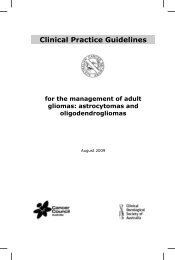Clinical Practice Guidelines for the management of locally advanced ...
Clinical Practice Guidelines for the management of locally advanced ...
Clinical Practice Guidelines for the management of locally advanced ...
Create successful ePaper yourself
Turn your PDF publications into a flip-book with our unique Google optimized e-Paper software.
CAB. The evidence provided in favour <strong>of</strong> bicalutamide mono<strong>the</strong>rapy having a BMD-protective<br />
property is not relevant as this agent (and class <strong>of</strong> drug) is not approved <strong>for</strong> use as mono<strong>the</strong>rapy in<br />
Australia.<br />
Evidence summary Level References<br />
For men with prostate cancer, both LHRH agonists and bilateral<br />
orchidectomy significantly reduce bone mineral density, continuing<br />
to do so over time, resulting in an increased likelihood <strong>of</strong><br />
pathological fracture <strong>of</strong> vertebral bodies and hips from osteoporosis.<br />
There is insufficient evidence to make a definite comment on<br />
intermittent androgen deprivation.<br />
There is insufficient evidence to comment on whe<strong>the</strong>r <strong>the</strong>re is a<br />
worse or diminished effect on BMD with combined androgen<br />
blockade (CAB) versus castration mono<strong>the</strong>rapy.<br />
Bicalutamide mono<strong>the</strong>rapy is not associated with reductions in<br />
BMD.<br />
Recommendation<br />
III-2, III-<br />
3, IV<br />
II 24,25<br />
39, 40, 44,<br />
47, 49, 50<br />
36, 37, 41,<br />
43, 45, 51,<br />
42, 52-<br />
55,56,46,38<br />
Be<strong>for</strong>e commencing patients on androgen deprivation <strong>the</strong>rapy, consider <strong>the</strong> likely duration<br />
<strong>of</strong> that treatment and <strong>the</strong> risk–benefit analysis <strong>for</strong> <strong>the</strong> indication <strong>for</strong> treatment, and take into<br />
account <strong>the</strong> effects on bone mineral density and risks <strong>of</strong> pathological fractures from<br />
osteoporosis.<br />
Grade C<br />
In addition, consider BMD measurements at baseline and subsequently during treatment with <strong>the</strong><br />
possibility <strong>of</strong> instituting preventative measures (calcium, vitamin D and exercise) as appropriate <strong>for</strong><br />
good musculoskeletal health, as well as <strong>the</strong> use <strong>of</strong> bisphosphonates as indicated by <strong>the</strong> Pharmaceutical<br />
Benefits Scheme <strong>for</strong> osteoporosis.<br />
Effects on quality <strong>of</strong> life<br />
Only three randomised controlled trials comparing different hormone <strong>the</strong>rapies and including men<br />
with <strong>locally</strong> <strong>advanced</strong> non-metastatic disease examined quality <strong>of</strong> life outcomes using validated<br />
questionnaires. 11, 21, 57-60 One trial used <strong>the</strong> EORTC QLQ C-30 instrument with <strong>the</strong> prostate cancer<br />
supplementary module and <strong>the</strong> Depression Anxiety Stress Scales, and two trials used <strong>the</strong> healthrelated<br />
QLQ instrument published by Cleary et al. 61 The longest follow-up was only 12 months.<br />
57, 58<br />
None <strong>of</strong> <strong>the</strong> instruments used directly assessed <strong>the</strong> impact <strong>of</strong> ADT-related symptoms such<br />
gynaecomastia and hot flushes on quality <strong>of</strong> life.<br />
Overall <strong>the</strong> evidence was limited. There were variations (albeit with a degree <strong>of</strong> overlapping<br />
commonality) in <strong>the</strong> types <strong>of</strong> ADTs employed, <strong>the</strong> instruments used and <strong>the</strong> numbers <strong>of</strong> domains<br />
assessed and reported. There were also variations in <strong>the</strong> way in which quality-<strong>of</strong>-life changes were<br />
reported and analysed. Quality <strong>of</strong> life was not a primary outcome in virtually all <strong>of</strong> <strong>the</strong>se studies. All<br />
were <strong>of</strong> low quality, with attrition greater than 20% or unclear in two <strong>of</strong> <strong>the</strong> three studies.<br />
Different risk and benefit analyses apply to men being treated with long-term adjuvant ADT <strong>for</strong><br />
<strong>locally</strong> <strong>advanced</strong> disease and men being treated with ADT <strong>for</strong> metastatic disease. One study included<br />
patients with metastatic disease as well as <strong>locally</strong> <strong>advanced</strong> disease.<br />
<strong>Clinical</strong> practice guidelines <strong>for</strong> <strong>the</strong> <strong>management</strong> <strong>of</strong> <strong>locally</strong> <strong>advanced</strong> and metastatic prostate cancer<br />
11, 21,<br />
24



